大理崇圣寺三塔PPT课件
- 格式:ppt
- 大小:1.22 MB
- 文档页数:20

¡¡¡¡Today we are going to visit the three pagodas temple of Dali. Welcome, everyone!¡¡¡¡Before we got the three pagodas temple, I would like to give you a brief introduction of Dali. Why is it called ¡°Dali¡±? As we all know Dali has a long history. After the Kingdom of NanZhao, Duansiping Established the Kingdom of Dali. ¡°li¡± this Chinese word refers to ¡°manners¡±, indicated the hope of the king that make his country a prosperous and civilized place.¡¡¡¡Dali is a world ¨Cfamous tourist attraction. It is rich in cultural heritages and tourist resources. Dali is widely claimed as ¡°the Oriental Switzerland¡±, ¡°the Chinese Geneva¡± and ¡°the Pearl on the Yunnan Plateau¡±. Each year, it attracts thousands of tourists both at home and from abroad to pay a visit. For example, the Cangsang mountain, Erhai lake, Dali Ancient city and the Three Pagodas are all important resorts in Dali. And we are all familiar with the saying:¡±wind, flowers, snow and the moon¡±, which refers to the snow on Cangshan mountain, the moon of the Erhai Lake, the wind of Shangguan county and the flowers in Xiaguang county. There are regarded as the best sight of Dali. We will enjoy them later.¡¡¡¡The Bai Nationality is the chief nationality in Dali Prefecture. It has the second biggest population among the 25 ethnic minorities in Yunnan, totaling more than 1,000,000 people. The Bai people have a long history and a well-developed culture. Under the influence of the Han people, some of their customs and habits are quite similar to those of the Han people. As our bus keeps moving on towards Dali, you will see more and more houses and villiages that have a strong local colour of the Bai people.¡¡¡¡Dali City is the capital of the Bai Autonomous Prefecture. As the largest city in the west of Yunnan, it covers an area of 1,400 square kilometers with a population of more than 450,000. In addition, Dali City is the political, economic and cultural center of Dali, as well as one of the important gateways to the Southeast Asian nations.¡¡¡¡OK, everyone, we are now at the Three Pagodas Temple. Let¡¯s go inside and see.¡¡¡¡Three Pagodas are the ancient landmarks. They have been the symbol of Dali. The temple located in the piedmont of Cangshan mountain and the near the Erhai Lake. The three pagodas are the only building of the temple. Because the temple went through the war and has been ruined. In Chinese we call it ¡°cong shen¡±, which means admiring the Buddha, and this Buddha refers to the ¹ÛÒô.¡¡¡¡After cross this plaza we will be in the temple. See ,the three pagodas stand there. The major Pagoda, built during the period of NanZhao State, stands 69 meters in height and is divided into 16 tiers. Each tier is inlaid with the statues of Buddha. On its front, four Chinese characters are quite striking, meaning ¡°Ensuring Tranquility toMountains and Rivers Forever.¡± From this, we can conclude that one of the reasons to built this pagoda is to prevent disasters. This pagoda, we call it ¡°Ç§Ñ°¡±.¡¡¡¡I am sure you have noticed the two small pagodas. They were built at the beginning of 10th century during the period of Dali State. Each Stands 42 meters in height and is divided into 10 tiers. They are made from bricks. ¡¡¡¡The three pagodas have a history of more than 1,000 years. They have warthered the storms and earthquakes several years. Still, the three pagodas stand firm and erect. They clearly show us the exquisite and superb craftsmanship of the ancient Chinese architecture.¡¡¡¡In recent years, the local government renovated the three pagodas. During the renovation, inside the major pagoda were found lots of treasures: Buddhist Sciptures, gold, silver, bronze and iorn wares, pearl, agate, amber, jade and some herbs, totaling more than 600 pieces.¡¡¡¡These three pagodas make a beautiful picture. If seen from a far distance, you will have such a feeling that how can this miracle exist in this world. Every time when I saw them, I always wondered that. They are really the wonderful works made by Bai people.¡¡¡¡This way, please, everyone. Now we can see the Statue of Yutong ¹ÛÒô. It is a rebuilt one, the original one was destroyed before. This statue is different from other statues of¹ÛÒô in other places around China. What¡¯s the difference? Please look at it clearly. It¡¯s face looks like a woman¡¯s face, and it¡¯s body resembles a man¡¯ s body. This feature can not be found in other statue.¡¡¡¡After visiting the temple, we will go to enjoy the scenery of Cangshan mountain and Erhai Lake, Ok ,Let¡¯s go, everyone.。
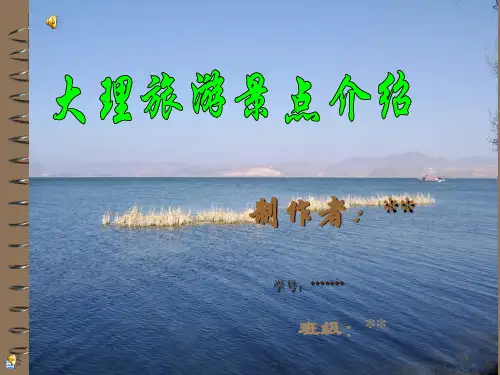
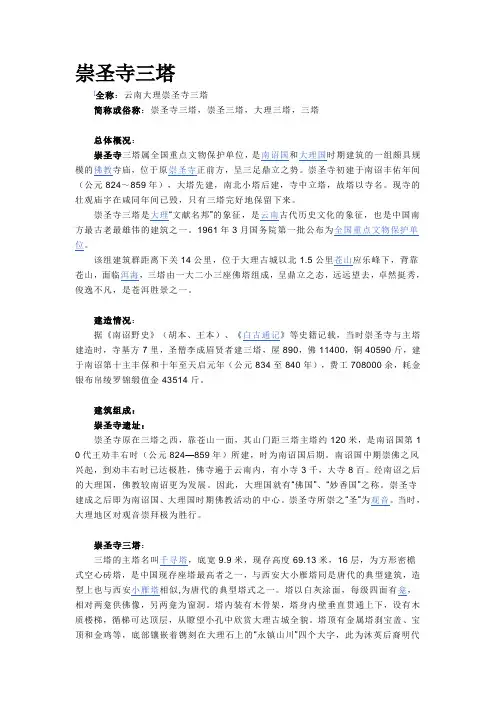
崇圣寺三塔[全称:云南大理崇圣寺三塔简称或俗称:崇圣寺三塔,崇圣三塔,大理三塔,三塔总体概况:崇圣寺三塔属全国重点文物保护单位,是南诏国和大理国时期建筑的一组颇具规模的佛教寺庙,位于原崇圣寺正前方,呈三足鼎立之势。
崇圣寺初建于南诏丰佑年间(公元824~859年),大塔先建,南北小塔后建,寺中立塔,故塔以寺名。
现寺的壮观庙宇在咸同年间已毁,只有三塔完好地保留下来。
崇圣寺三塔是大理“文献名邦”的象征,是云南古代历史文化的象征,也是中国南方最古老最雄伟的建筑之一。
1961年3月国务院第一批公布为全国重点文物保护单位。
该组建筑群距离下关14公里,位于大理古城以北1.5公里苍山应乐峰下,背靠苍山,面临洱海,三塔由一大二小三座佛塔组成,呈鼎立之态,远远望去,卓然挺秀,俊逸不凡,是苍洱胜景之一。
建造情况:据《南诏野史》(胡本、王本)、《白古通记》等史籍记载,当时崇圣寺与主塔建造时,寺基方7里,圣僧李成眉贤者建三塔,屋890,佛11400,铜40590斤,建于南诏第十主丰保和十年至天启元年(公元834至840年),费工708000余,耗金银布帛绫罗锦缎值金43514斤。
建筑组成:崇圣寺遗址:崇圣寺原在三塔之西,靠苍山一面,其山门距三塔主塔约120米,是南诏国第1 0代王劝丰右时(公元824—859年)所建,时为南诏国后期。
南诏国中期崇佛之风兴起,到劝丰右时已达极胜,佛寺遍于云南内,有小寺3千,大寺8百。
经南诏之后的大理国,佛教较南诏更为发展。
因此,大理国就有“佛国”、“妙香国”之称。
崇圣寺建成之后即为南诏国、大理国时期佛教活动的中心。
崇圣寺所崇之“圣”为观音。
当时,大理地区对观音崇拜极为胜行。
崇圣寺三塔:三塔的主塔名叫千寻塔,底宽9.9米,现存高度69.13米,16层,为方形密檐式空心砖塔,是中国现存座塔最高者之一,与西安大小雁塔同是唐代的典型建筑,造型上也与西安小雁塔相似,为唐代的典型塔式之一。
塔以白灰涂面,每级四面有龛,相对两龛供佛像,另两龛为窗洞。

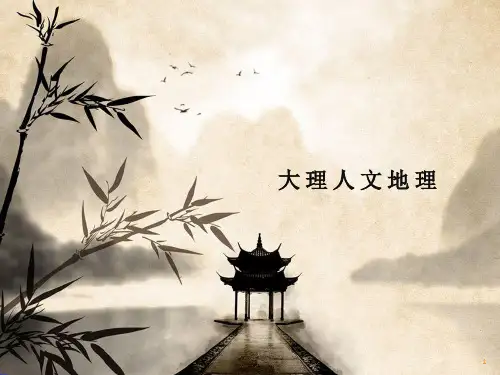


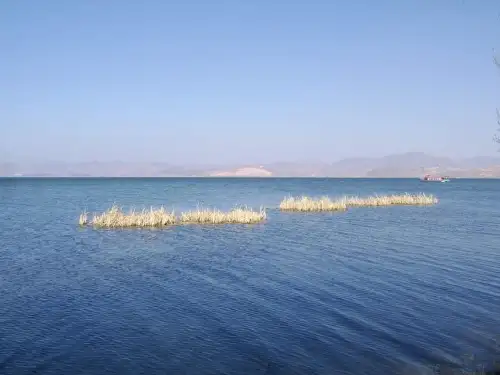
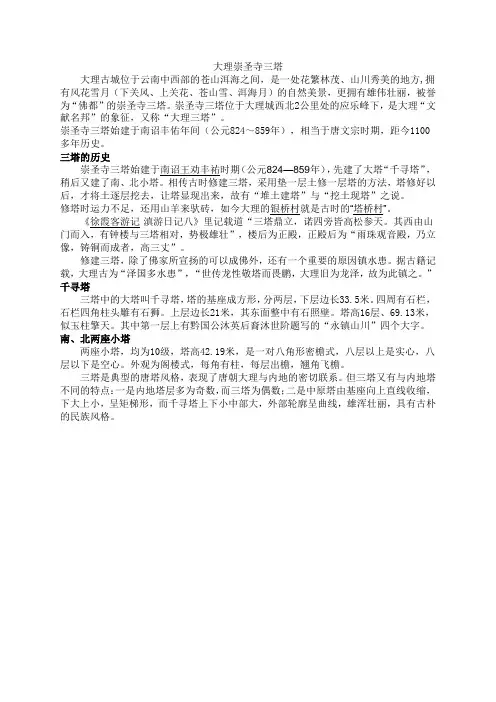
大理崇圣寺三塔大理古城位于云南中西部的苍山洱海之间,是一处花繁林茂、山川秀美的地方,拥有风花雪月(下关风、上关花、苍山雪、洱海月)的自然美景,更拥有雄伟壮丽,被誉为“佛都”的崇圣寺三塔。
崇圣寺三塔位于大理城西北2公里处的应乐峰下,是大理“文献名邦”的象征,又称“大理三塔”。
崇圣寺三塔始建于南诏丰佑年间(公元824~859年),相当于唐文宗时期,距今1100多年历史。
三塔的历史崇圣寺三塔始建于南诏王劝丰祐时期(公元824—859年),先建了大塔“千寻塔”,稍后又建了南、北小塔。
相传古时修建三塔,采用垫一层土修一层塔的方法,塔修好以后,才将土逐层挖去,让塔显现出来,故有“堆土建塔”与“挖土现塔”之说。
修塔时运力不足,还用山羊来驮砖,如今大理的银桥村就是古时的“塔桥村”。
《徐霞客游记·滇游日记八》里记载道“三塔鼎立,诺四旁皆高松参天。
其西由山门而入,有钟楼与三塔相对,势极雄壮”,楼后为正殿,正殿后为“雨珠观音殿,乃立像,铸铜而成者,高三丈”。
修建三塔,除了佛家所宣扬的可以成佛外,还有一个重要的原因镇水患。
据古籍记载,大理古为“泽国多水患”,“世传龙性敬塔而畏鹏,大理旧为龙泽,故为此镇之。
”千寻塔三塔中的大塔叫千寻塔,塔的基座成方形,分两层,下层边长33.5米。
四周有石栏,石栏四角柱头雕有石狮。
上层边长21米,其东面整中有石照壁。
塔高16层、69.13米,似玉柱擎天。
其中第一层上有黔国公沐英后裔沐世阶题写的“永镇山川”四个大字。
南、北两座小塔两座小塔,均为10级,塔高42.19米,是一对八角形密檐式,八层以上是实心,八层以下是空心。
外观为阁楼式,每角有柱,每层出檐,翘角飞檐。
三塔是典型的唐塔风格,表现了唐朝大理与内地的密切联系。
但三塔又有与内地塔不同的特点:一是内地塔层多为奇数,而三塔为偶数;二是中原塔由基座向上直线收缩,下大上小,呈矩梯形,而千寻塔上下小中部大,外部轮廓呈曲线,雄浑壮丽,具有古朴的民族风格。
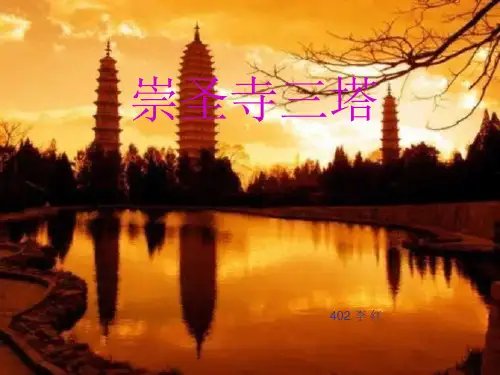
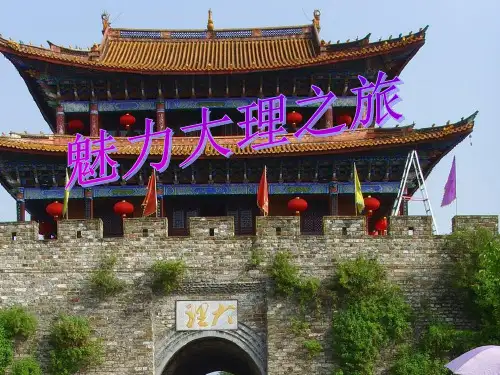
(1)必讲内容崇圣寺历史---三塔布局---塔的基本知识---千寻塔---“永镇山川”照壁---南北两小塔---建塔方法---陈列馆(2)选讲内容:建极大钟楼钟楼概况---建极大钟的前世今生---钟的设计铸造者大理崇圣寺三塔导游词各位朋友,大家好!崇圣寺三塔文化旅游区热烈欢迎您的光临!崇圣寺三塔是国务院首批公布的全国重点文物保护单位,国家5A级旅游区。
崇圣寺三塔是大理的标志和象征,是南诏、大理国时期佛教文化盛极一时的历史见证,也是古代大理各族人民精湛建筑艺术的集中体现。
各位朋友大家请看,耸立在我们面前的就是崇圣寺三塔,历史上崇圣寺的山门即在三塔之后。
三塔前一后二,大塔居前,与两小塔等距70米;两小塔南北对峙,相距97米;与大塔成等腰三角形,布局为鼎足之势。
三塔历代为大理的象征,是我国南方最壮丽的塔群。
塔起源于印度,是随着佛教传入中国的。
塔原是供奉佛祖释迦牟尼舍利子的半圆形坟冢。
塔作为佛教的象征,与寺庙并存,有寺必有塔。
塔藏也从“生身舍利”演化为“法身舍利”。
主塔又名千寻塔,全称“法界通灵明道乘塔”,与崇圣寺同时建于南诏劝丰佑时期,塔高69.13米,为16级方形密檐式空心砖塔,是我国少有的层数较多的偶数层塔,也为中国现存最高的唐塔。
千寻塔自下而上由塔基、塔身和塔刹三部分组成。
塔身矗立在三层高大的台基之上,共十六级,外形轮廓不是僵直的直线向上,而是上下向内微收,中部略凸的曲线,呈梭形。
每级四面有龛,相对两龛供佛像,另两龛为窗洞,相邻两级窗洞方向交替错开,利于塔内采光通风,且增强塔的坚固性。
十五级以上为实心,塔顶方形砖砌须弥座承托铜制覆钵,上置玲珑塔刹,直指苍穹。
千寻塔须弥座朝东一面有一照壁,照壁上有“永镇山川”四个楷书大字,每字高1.7米,为明万历十一年,黔国公裔孙沐世阶所书。
题这四个字的原因有两种说法:一种认为大理地区多水患,治水需治龙,而龙敬塔畏鹏,建塔并置大鹏鸟可镇龙,意在镇服水患;另一种说法是大理被纳入明朝版图后,镇守云南的黔国公后人在屹立不倒的塔前题下“永镇山川”,意在世代镇守云南山川。
[键入文字]崇圣寺三塔崇圣寺三塔(见初中《中国历史》第二册彩色插图)位于云南省西部高原白族自治州境内的大理。
大理左顾苍山,右跳洱海,城郭奠山海之间,楼阁出烟云之上,是滇西南高原上一个美丽的都市。
大理是夷语“好渡”的意思。
五代时候,这地方有个大理国,为后晋天福二年(公元937 年)白族段思平所建。
1253 年忽必烈征云南灭大理始建云南省。
改大理为太和,属大理府管辖。
崇圣寺三塔在云南大理县城西北崇圣寺。
崇圣寺又叫三塔寺,是国内外闻名的南诏名胜之一,是一座建于六诏时的古刹。
据《续云南通志》记载:“崇圣寺前有三塔,寺内有观音像,高二丈四尺,唐蒙时董善明铸。
”现在寺院建筑早已荡然无存,只有寺前三塔仍巍然屹立,这就是著名的大理崇圣寺三塔。
三塔包括方形16 层的千寻塔一座和小塔两座。
千寻塔在前,双塔在后,前后相距约30 米。
三塔鼎足而立,都是用砖砌筑而成的密檐式塔。
千寻塔是三塔中最大的塔,位于南北两座小塔前方中间,所以又称中塔。
塔的全名为“法界通灵明道乘塔”,建于唐代南诏保和时期(824-839 年)。
塔高69.13 米,塔心中空,在古代有井字形楼梯可以供人攀登。
通体自上而下有两重塔基、塔身。
塔身每层正面中央开券龛,龛内有白色大理石佛像一尊。
两边龛为窗洞,两级窗洞的方向交替错开,解决了塔内的采光通风问题。
塔檐越往上间距越小,自第三、四层起逐层向内收束,最后集束于塔顶。
因此塔身的外形轮廓不是僵硬地直线向上,而是微凸。
其形制与西安小雁塔略同。
塔顶四角各有一只铜铸的金鹏鸟,传说用以镇压洱海中的龙妖水怪。
王昶在《金石萃编》中记载:“多铸金为顶,顶有金鹏,世传龙性敬塔而畏鹏,大理旧为龙泽,故为此镇之。
”塔下有黔国公沐氏楷书“山海大观”四个大字。
文石凿成,每字纵横4 丈。
塔前照壁上镶有大理石镌刻“水镇山川”四字,是明黔国公沐氏的裔孙沐世阶所书,字体苍劲有力。
塔的底层高约13 米。
1。